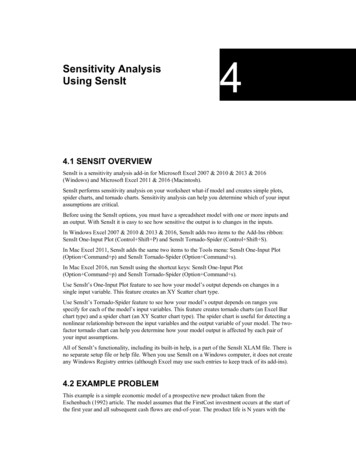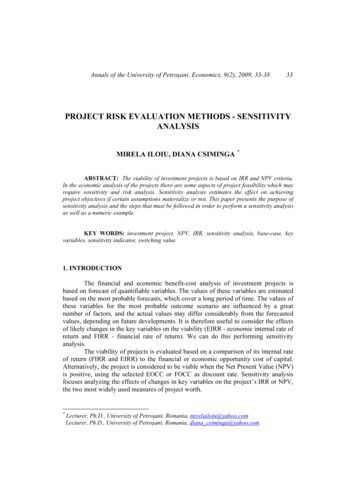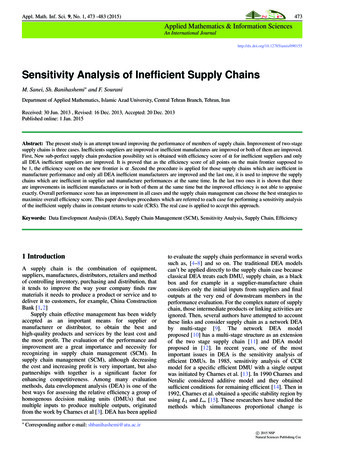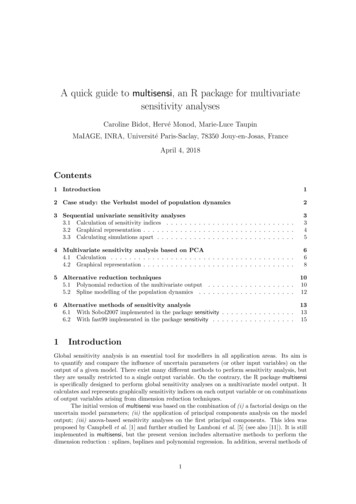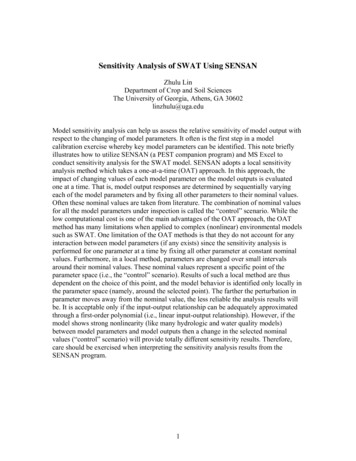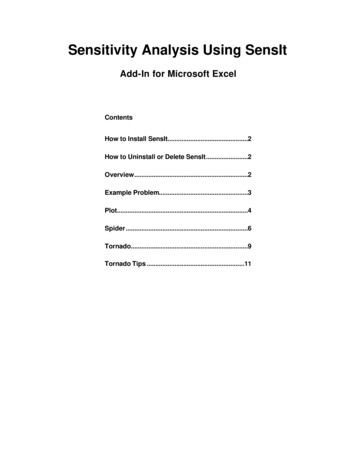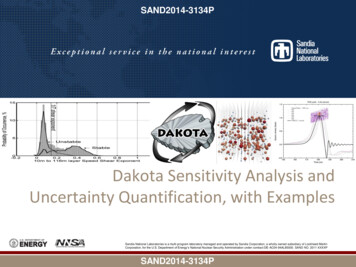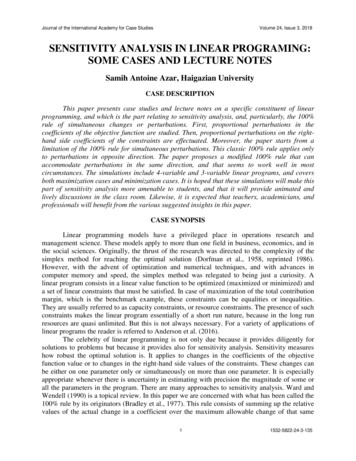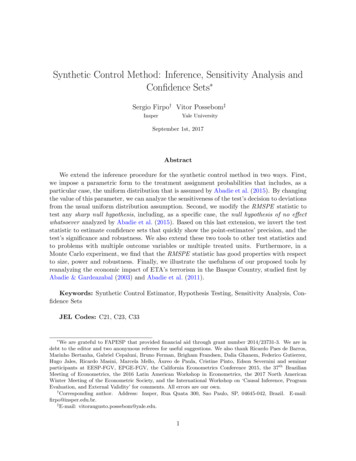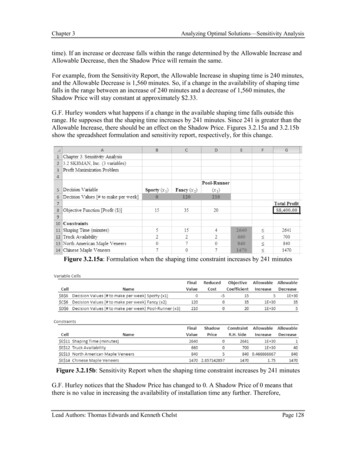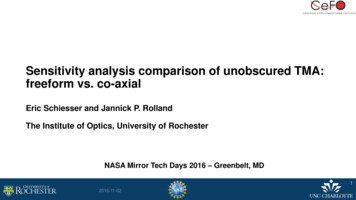
Transcription
Sensitivity analysis comparison of unobscured TMA:freeform vs. co-axialEric Schiesser and Jannick P. RollandThe Institute of Optics, University of RochesterNASA Mirror Tech Days 2016 – Greenbelt, MD12016-11-02
Motivation for this comparison Freeform allows for more freedom in geometry (volume, beam direction) Potential design tradeoff with alignment sensitivity What is the extent of this tradeoff? We need a comparison with a traditional TMA Other direct TMA comparisons have been made Thompson [EOSAM 2014, OptiFAB 2015] showed that a certain freeform geometrywas at least not more sensitive than a slower TMA with faster mirrors We desire to compare sensitivity of a compact fully freeform geometry toan equivalent traditional co-axial TMA or a non-co-axial TMA but with offaxis aspheres Same 1st order specificationsSimilar volumes (to the extent possible)Same FFOVNo intermediate image22016-11-02
Results from previous workCo-axial starting points(co-axial single-conic equations)CompactInternal image,negative primary Internal imageCompactSchwarzschild-likeNegative primary1-6 circular full FOV250 mm apertureF/3 (750 mm EFL)Broad spectral coverage (UV, Vis., NIR, FIR)Compact footprintDiffraction-limitedfreeform designsNone: tertiarytoo largeNegative primaryNegative primaryCompactNone: BFLtoo smallE. Schiesser et al. FiO 201632016-11-02
Compact freeform design16:54:2613:07:40Co-axial TMAFreeform three-mirror imagerDesign method: Starts from a 3rd order correctedco-axial TMA Mirrors are tilted to removeobscurationUnobscured(tilted surfaces) Freeform surface shapes andfinal geometry optimized torecover performanceV 0.0793 m3 79 L42016-11-02
Compact freeform design13:07:40V 0.0793 m352016-11-02
Baseline TMA designthreemrc.seqDesign method: Starts from a “three-mirror compact”(TMC) A.K.A. “reflecting Cooke triplet”design [Egdall 1985] CODE V “threemrc.seq” sample lens Scaled to relevant focal length (aperturereduced to match F/#)Design Optimized to Ensure diffraction limited performance Match FFOV of freeform design Match volume (to extent possible) offreeform for diffraction limitedperformanceEgdall, Ira M. "Manufacture of a three-mirror wide-field opticalsystem." Optical Engineering 24.2 (1985): 242285.Baseline TMA optimized for compactnessScaled,matchFFOV11:34:00V 0.117 m3Optimize surfaces,decrease volumeV 0.097 m397L (22% larger)62016-11-02
Compact TMA design72016-11-02
System comparison17:24:59Compact FreeformTMCEPD (mm)250250F/#F/3F/3FFOV (degrees)2.6 2.6 Volume (m 3)0.07930.0965 (22% larger)Max Mirror Diameter (mm) 256300 (18% larger)Surface shapesFringe Zernike Polynomials,centered on central field12th order Qcon aspheresField BiasN/A5.5 Aperture Offset (mm)N/A22282016-11-02
Opto-mechanical design: current iteration Monolithic frame with optics mounted from outside Rectilinear flexures provide load on kinematic coupling 2 piece cap style enclosure (not pictured) Optics utilize kinematic mounts(3 Vee – 3 Sphere) Fiducials machined along chamferjust outside clear aperture All features machined during opticsurface fabrication setupCourtesy of Matt Davies’ team at UNC Charlotte92016-11-02
TMC Sensitivity Analysis102016-11-02
TMC nominal performance0.25λ Limited by fieldconjugate astigmatismand field curvature112016-11-02
TMC with tip/tilt and X-Y decenter, refocus Tip/tilts: 87 µrad Decenter/Despacing:18 µm0.25λ All mirrors perturbed toextreme values of tolerances Image plane allowed to refocus Result: mostly field-constantastigmatism, coma node shifts Average RMS WFE over fullfield is not diff. lim.122016-11-02
TMC after refocus and M3 tip/tilt compensators Added M3 tip/tilt ascompensator Average RMS WFErecovers to within0.0004 of nominal Coma node remainsshifted0.25λM3 compensation:X-Axis: 0.0058 Y-Axis: 0.0088 Note: relative scaling132016-11-02
Freeform SensitivityAnalysis142016-11-02
Freeform nominal full-field performance17:24:59 Limited primarily byhigher-orderastigmatism (in field)0.25λ Uncommon fielddependence152016-11-02
Freeform with tip/tilt and X-Y decenter, refocus17:24:59 Tip/tilts: 87 µrad Decenter/Despacing:18 µm0.25λ All mirrors perturbed toextreme values of tolerances Image plane allowed to refocus Result: field-constantastigmatism Average RMS WFE over fullfield is not diff. lim.162016-11-02
Freeform after refocus and M3 tip/tilt compensators17:24:59 Added M3 tip/tilt ascompensator Average RMS WFErecovers to within 0.002 λof nominal Coma node returns tocenter0.25λM3 compensation:X-Axis: 0.00016 Y-Axis: 0.0011 172016-11-02
Surface departure-from-sphereFreeformColor range: [-0.3, 0.3] mmTMCColor range: [-0.05, 0.05] mm182016-11-02
Summary In this early comparison: Freeform is more compact by 22%Both designs (compact freeform and TMC) require a compensatorBoth designs can recover performanceFreeform exhibits primarily field-constant astigmatism with perturbation, which canbe easily compensated TMC also exhibits (less) field-constant astigmatism, requires more compensatormovement to correct (design tradeoff?) Study is on-going This first-iteration compact freeform may benefit from methods developed by Bauer(2015) which may reduce DFS and slope (reducing sensitivity to alignment)A. Bauer, J. P. Rolland. Optics express 23.22 (2015)192016-11-02
AcknowledgementsNSF I/UCRC Center for Freeform Optics (CeFO)www.CenterFreeformOptics.orgThanks to Synopsys for the studentlicense of CODE V 202016-11-02
Backup slides212016-11-02
Compact freeform design13:07:40V 0.0793 m3222016-11-02
was at least not more sensitive than a slower TMA with faster mirrors We desire to compare sensitivity of a compact fully freeform geometry to an equivalent traditional co-axial TMA or a non-co-axial TMA but with off-axis aspheres Same 1st order specifications Similar volumes (to the extent possible) Same FFOV No intermediate image
